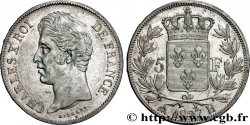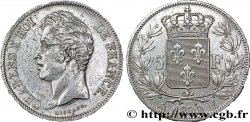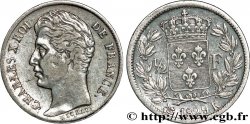正面
正面的文字 A CHARLES X ROI DE FRANCE - LES MULHOUSIENS RECONNAISSANS.
正面的说明书 Tête de profil à droite, signé : BARRE F.T.
背面
背面的文字 LE ROI ET LE DAUPHIN ONT VISITE LA VILLE DE MULHAUSEN LE 11 SEPTEMBRE 1828 // HENRI IV . VOUS APPELAIT / SES BONS AMIS / ALORS VOUS ETIEZ SUISSES / AUJOURD’HUI / VOUS ETES FRANCAIS / ET VOUS ETES AUSSI / MES BONS AMIS.
背面的说明书 Blason tourelé à l’exergue entre un caducée et une branche de laurier. Légende circulaire et en 8 lignes.
历史细节
CHARLES X
(09/16/1824-08/2/1830)
Charles X, grandson of Louis XV and younger brother of Louis XVI, is known as Comte d'Artois. He succeeded Louis XVIII on September 16, 1824. His reign begins with liberal measures without follow-up. Charles X is the last king crowned in Reims, May 29, 1825. He leaves the government to Villèle which takes reactionary measures such as the law of compensation for emigrants of one billion gold francs or the dismissal of the National Guard. Despite the dissolution of the Chamber in 1821, the liberal opposition was strengthened and, in January 1828, Villèle was replaced by Martignac who tried to appease. Quickly fired in August 1829, Martignac was replaced by a representative of the ultras, Polignac. The king dissolves the Chamber on May 16, 1830 but the new chamber elected in July again has a liberal majority. Charles X then promulgates four ordinances which aim to limit the powers and freedoms of the House and tend to suspend the charter of 1814. This causes the revolution of July 27/29, better known as the "Trois Glorieuses". On August 2, 1830, Charles X abdicated in favor of his grandson Henri V, after appointing Louis-Philippe lieutenant general of the kingdom.










 对产品描述纠错
对产品描述纠错 打印
打印 分享我的选择
分享我的选择 提问
提问 Consign / sell
Consign / sell
 产品介绍
产品介绍










